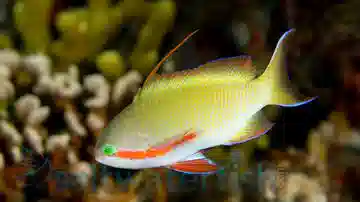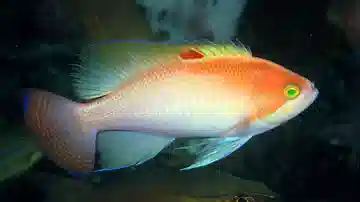Tiger Queen Anthias
Pyronotanthias lori cf.
(1 Reviews)

Tiger Queen Anthias
Pyronotanthias lori cf.
(1 Reviews)
{{ item.name }}
Size: {{ item.extra_field_3 }}
${{ getFormattedPrice(item.saleprice) }} ${{ getFormattedPrice(item.price) }}
To join the waiting list, click here
Free Shipping
With
$199.00
or more in Marine Life.
More details...
Tiger Queen Anthias Care Facts
| Care Level: | Moderate |
|---|---|
| Temperament: | Peaceful |
| Diet: | Carnivore |
| Reef Safe: | Yes |
| Minimum Tank Size: | 70 gallons |
| Max Size: | 5 inches |
Explore the Beauty of the Tiger Queen Anthias with Saltwaterfish.com
Introducing the Tiger Queen Anthias (Pyronotanthias lori cf.), a stunning addition to your saltwater marine aquarium. With its vibrant colors and captivating presence, this fish species is a favorite among marine enthusiasts. This comprehensive product description will provide you with essential information about the Tiger Queen Anthias to help you make an informed decision for your aquatic environment.
Habitat of the Tiger Queen Anthias: Originating from the Warm Waters of the Indian Ocean
Originating from the warm waters of the Indian Ocean, specifically the Western Indian Ocean and the Red Sea, the Tiger Queen Anthias thrives in coral-rich environments, typically found at depths ranging from 30 to 60 meters. In the wild, they prefer areas with ample hiding spots and rocky crevices to seek refuge.
Reef Compatibility of the Tiger Queen Anthias: A Graceful Beauty in Reef Tanks
The Tiger Queen Anthias is considered reef-safe. These fish do not exhibit aggressive behavior towards corals or other reef inhabitants. Their peaceful nature makes them ideal for reef aquariums, where they can coexist harmoniously with various corals and invertebrates.
Size and Lifespan of the Tiger Queen Anthias: Sexual Dimorphism and Longevity
This species exhibits sexual dimorphism, with males being larger and more vibrant in color than females. Adult males can reach sizes up to 6 inches, while females tend to be slightly smaller, usually around 4-5 inches. With proper care, Tiger Queen Anthias can live in captivity for approximately 5 to 7 years.
Diet of the Tiger Queen Anthias in Captivity: A Varied and Nutritious Menu
Feeding the Tiger Queen Anthias is relatively straightforward. They are omnivorous and enjoy a varied diet, including high-quality flake food, pellets, frozen foods such as Mysis shrimp, and small live or frozen brine shrimp. Regular feeding, multiple times a day, ensures their health and vitality.
Aquacultured Availability of the Tiger Queen Anthias
Tiger Queen Anthias are occasionally available through aquaculture efforts, although they are more commonly collected from the wild. Purchasing from reputable suppliers like Saltwaterfish.com ensures the sustainability of this species, as they prioritize responsible sourcing and the well-being of marine ecosystems.
Compatibility of the Tiger Queen Anthias with Other Fish and Invertebrates: Peaceful Coexistence
This Anthias species is generally peaceful and can coexist with a wide range of fish and invertebrates in a well-maintained aquarium. Here are five compatible tank mates to consider:
- Ocellaris Clownfish (Amphiprion ocellaris)
- Royal Gramma (Gramma loreto)
- Firefish Goby (Nemateleotris magnifica)
- Purple Firefish (Nemateleotris decora)
- Banggai Cardinalfish (Pterapogon kauderni)
Juvenile to Adult Coloration Changes in the Tiger Queen Anthias: A Delightful Transformation
Juvenile Tiger Queen Anthias display less vibrant colors than their adult counterparts. Their colors become more striking as they mature, with males showcasing the characteristic tiger-like stripes on their bodies. This transition is a delightful transformation to witness in your aquarium.
Temperament of the Tiger Queen Anthias: Peaceful and Friendly Aquarium Dwellers
Tiger Queen Anthias are known for their peaceful and friendly nature. They swim actively throughout the tank, adding movement and energy to your aquarium. Their non-aggressive disposition makes them suitable for community tanks.
Tank Requirements of the Tiger Queen Anthias: Creating the Ideal Habitat
To provide the best care for your Tiger Queen Anthias, consider the following tank requirements:
- Minimum Aquarium Size: A tank of at least 75 gallons is recommended to accommodate their active swimming habits and to provide ample space for multiple individuals.
- Water Conditions:
- pH: Maintain a stable pH level between 8.1 and 8.4.
- Salinity: Keep salinity levels at 1.020 to 1.025 specific gravity.
- Water Temperature: Maintain a temperature range of 75-80°F (24-27°C).
- Water Flow: Ensure moderate to strong water flow to mimic their natural habitat and aid in oxygenation.
Common Names of the Tiger Queen Anthias: Exploring Nomenclature
The Tiger Queen Anthias may also be known by other common names, including Lori Anthias, Queen Anthias, and Threadfin Anthias.
Why Choose Saltwaterfish.com: Assurance of Quality
When you purchase the Tiger Queen Anthias from Saltwaterfish.com, you select a supplier dedicated to providing top-quality marine life for your aquarium. Saltwaterfish.com is committed to responsible sourcing, ensuring the health and well-being of the species, and providing expert guidance for aquarium enthusiasts. With a reputation for excellence in the industry, you can trust Saltwaterfish.com to deliver healthy and vibrant Tiger Queen Anthias directly to your door.
In conclusion, the Tiger Queen Anthias (Pseudanthias lori) is a beautiful and peaceful addition to your saltwater marine aquarium. Its captivating appearance, reef compatibility, and ease of care make it an excellent choice for beginner and experienced marine hobbyists. Ensure a thriving aquatic environment by providing them with the appropriate tank size and water conditions. When you choose to purchase the Tiger Queen Anthias from Saltwaterfish.com, you are enhancing the beauty of your aquarium and supporting responsible and sustainable practices in the marine aquarium industry.
Very lovely. I thought Tiger Queen Anthias and the damsels were fighting, but it looks like they will seek him out and he will seek them. They seem to play in a way the damsels never did with each other. He stays closer to the bottom and doesn't come up to compete for food. I didn't think he was eating but then I realized my cheto was all but gone. Hungry as a herbivore.
Reviewed by: Tim Sprott on Sept. 11, 2021















